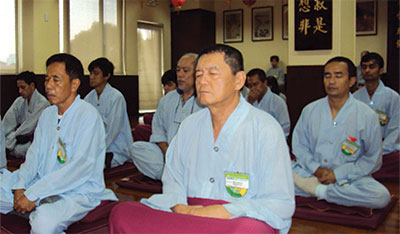Introduction to Zen Meditation
“When the mind is calm and clear, the truth reveals itself.”

- Zen meditation, known as “Chan” (禪) in Chinese, flourished in China around 700 A.D. Since then, it has become one of the most influential schools of Buddhism, spreading to Japan, Korea, Vietnam, and now to many western countries.
- Zen and other forms of Buddhist meditation have been found to help calm the mind and reduce stress, anxiety, depression, etc., and bring peacefulness, tolerance, and other positive attributes to life.
- By clearing our minds and reflecting inward, we can perceive our own Buddha nature, and uncover our innate wisdom and joy.
(I) Posture
- Sit up straight on the meditation cushion, with the body relaxed.
- Cross your legs in the lotus or half-lotus positions if you are able to do so.
- Let the arms hang down naturally.
- The hands form the diamond mudra (right hand in a fist holding both thumbs, and the left hand fingers covering the right hand) and are placed near the abdomen.
- Keep the head erect with the chin slightly down.
- Close your eyes or lower the eyes, looking down naturally (if the eyes are wide open, you may get distracted easily; if the eyes are closed, you may become drowsy easily.)
- The mouth should wear a slight smile.
(II) The breath
- Breathe through the nose, not with the mouth.
- Breathing should be quiet, free flowing, slow, deep, and even.
- As you exhale, start counting one, two, three, four, five, etc. As you inhale, do not count. Keep your focus on the breath this way continuously.
- Train yourself to do this well.
(III) Calm the mind
- Just concentrate on your breathing.
- You are not judging, reflecting, or analyzing. You are simply observing the moment in which you find yourself.
(IV) After sitting meditation
- After meditation, move your head, shoulders, and body slowly.
- Rub your palms together gently, and massage your face, ears, neck, body and legs.
- Take three deep breaths, each time bend the body forward and massage your legs as you exhale slowly.
- If the legs are sore or numb, don’t stand up immediately.
(V) Walking meditation -- "Wherever you are, that’s where your mind should be."
- Palms down. Body straight but relaxed.
- Look ahead to where you will step or at the person in front of you.
- Focus on how you are walking, where you’re putting your foot. Do not think of anything else. Always stay in the present moment.
The key to successful meditation is daily practice. Let mindfulness become a way of life.

